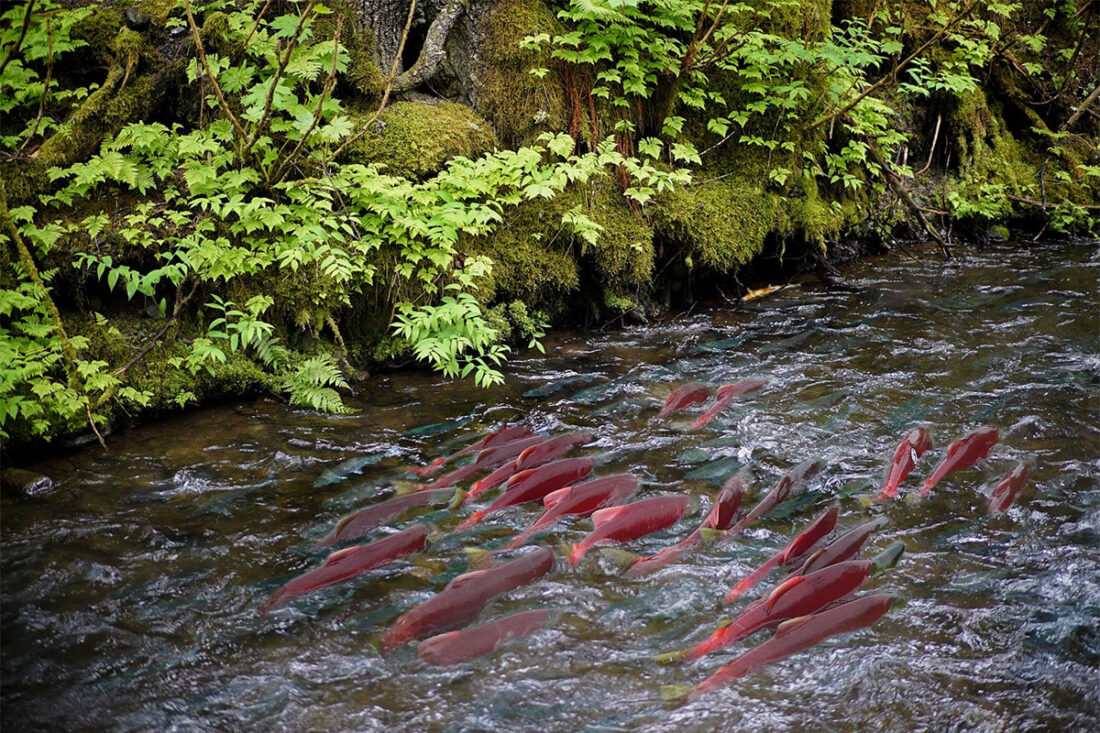One of the most important elements of becoming a successful freshwater angler is learning where the types of freshwater fish species you want to target live. Before you can catch a fish, you have to find it. To learn the habitats where specific species of freshwater game fish live, visit our freshwater game fish guide.
Below you’ll find a directory of the different habitats to look for when freshwater fishing.
- Cliffs and Steep Shore Banks
- Current Edges (Seams)
- Drift Lines and Winds
- Drop-offs
- Freshwater Lakes and Ponds
- Gradual Shores
- Inlets and Outlets
- Inside Turns and Coves
- Islands or Sand Bars
- Lake and Pond Fishing Holes
- Lily Pads
- Merging Currents
- Open Water
- Outside of Bends
- Overhanging Trees and Bushes
- Piers, Docks & Pilings
- Points and Break Lines
- Riparian Zones
- Ripples, Currents, Swirls and Sprays
- Rivers and Streams
- Rock and Boulder Pockets
- Rocks
- Small Pointed Waves
- Spring Holes
- Sunken Objects
- Walkways and Bridges
Cliffs and Steep Shore Banks
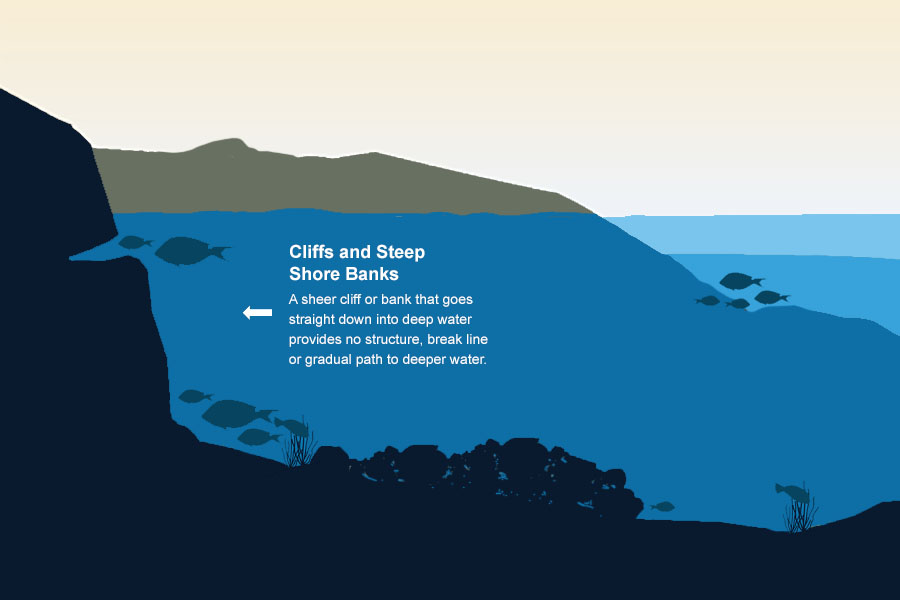
When a cliff or steep shore has a bank that drops directly into deep water, it doesn’t provide the type of environment that attracts fish. However, cliffs and banks can be good places to fish if they have ledges, underwater shelves or gentle slopes that lead out to deeper water. To determine if a cliff has an underwater shelf or slope, check the base for crumbled-off rock. These rocks are good places for deep-water fish to come to spawn or search for food.
Current Edges (Seams)
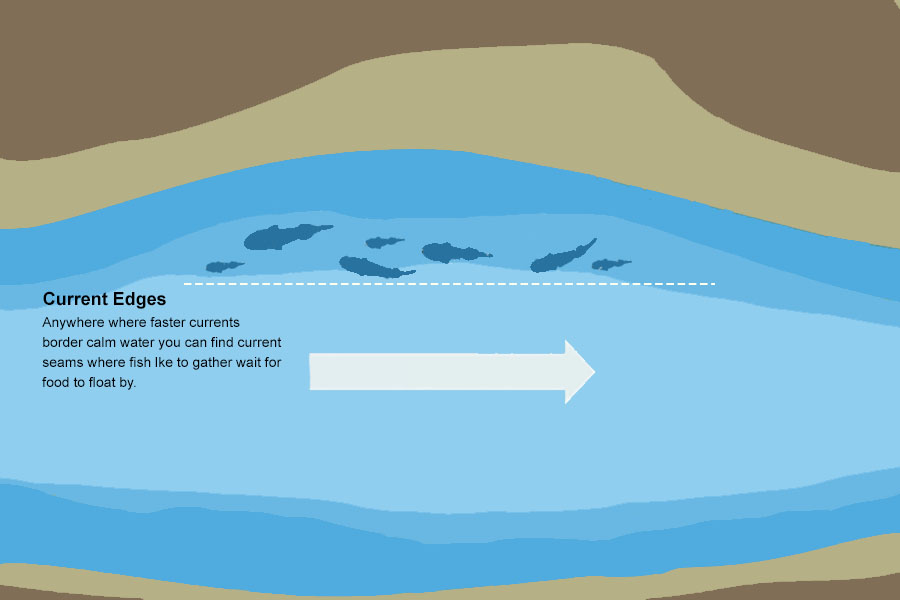
You can find current seams almost anywhere faster currents border calm water. Look for seams in areas where a stream is merging into a river or in areas that have swift water nearby, like pools and eddies.
You can also find seams in spots where a small inlet stream is flowing into a lake or other larger body of water. Fish like to gather here because they can sit in the calmer water, while waiting for food to float by on the stream’s current.
How to fish current seams
Many different conditions can cause a current seam. In the spots where the seam enters a lake, eddy or pool, use the previously mentioned techniques. However, if the seam is caused by two intersecting currents, it will create pockets of calm water big enough to hold a few fish. It’s more difficult to fish these spots with a lure or fly due to the surrounding current.
If you’re fishing these pockets, be patient and cast well upstream. You’ll want the water to guide your gear into the pocket, so allow some extra space between where you cast and where you ultimately want to end up.
Drift Lines and Wind
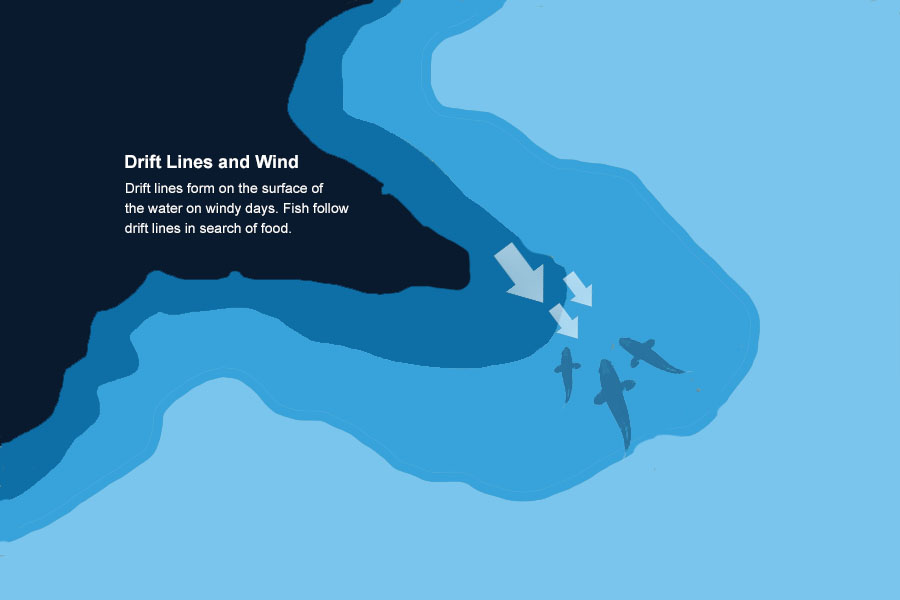
Drift lines form on the surface of the water on windy days. The wind pushes the surface water around which often pushes surface food around. Fish will often follow drift lines in search of food.
Drift lines will also bring food into shore along with hungry game fish. Breezy days can turn into pretty good fishing days. But take along a pro with you if you’re unfamiliar with the water. Wind can be tricky and unsafe.
Drop-offs
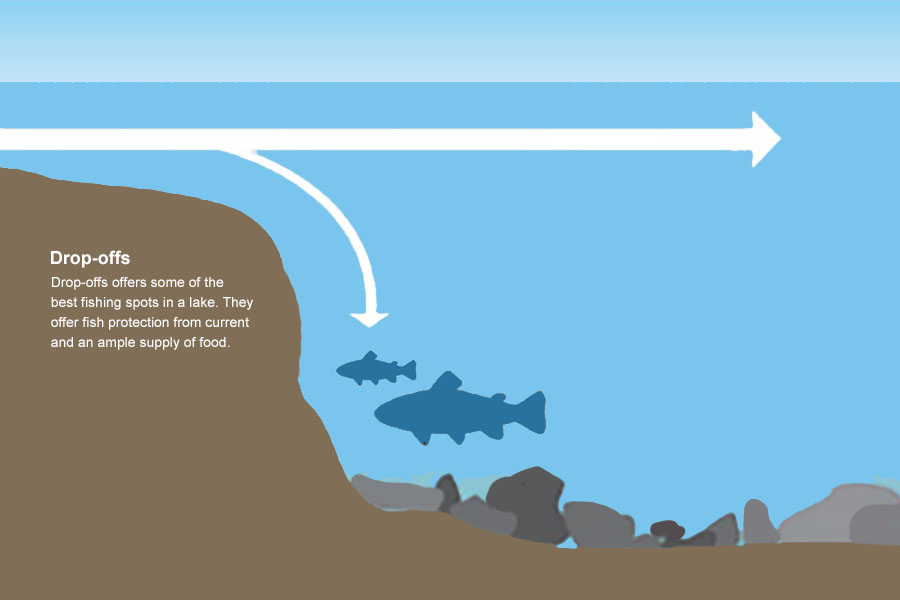
If you want to find the best spot to fish on a lake, try looking for a steep drop-off – the larger and more dramatic, the better. You’ll have even better luck if the drop-off has some grooves and twists. These formations act as a sort of fish superhighway by allowing fish to easily and safely travel through funnels and along walls.
Water falling over the drop-off carries food with it. As the water hits the bottom, it slows down and sinks, bringing the food to the fish waiting below. The deeper water, large food supply and the fact that it’s protected from the current make it the ideal place for fish to gather. This makes drop-offs great places to fish.
Freshwater Lakes and Ponds
If you’re a beginner, local ponds and fishing lakes are a good option for you because of the large amounts of fish that generally live there. Since they often produce plant life, they offer many places for fish to hide out and find food.
Fishing lakes and pond structures
Fish like to hang out anywhere they can find shade, protection and shelter. This is why logs, stumps, rocks, brush and docks are some of the favorite gathering places for fish. Lakes and ponds are the perfect places to find many of these types of structures, making them a great option for fishing. When fishing on lakes or ponds, you can fish from a boat, or from the shore. You’ll find fish all over the lake – from the shallow areas near the shore, to the deep areas in the middle. The types of fish you can catch include pickerel, panfish, salmon, perch, trout and smallmouth bass.
When you find a lake you’d like to fish, get familiar with the different areas around it. Pay attention to the locations where you find submerged objects, inlets, points, holes, reeds, weeds and sunken islands. These are all areas where there’s likely to be fish. Why fish near a structure? The reasoning is simple:
- Structures create shallow areas
- Shallow areas attract plant growth
- Plants attract small fish
- Small fish attract bigger fish – the fish you’re trying to catch
Gradual Shores
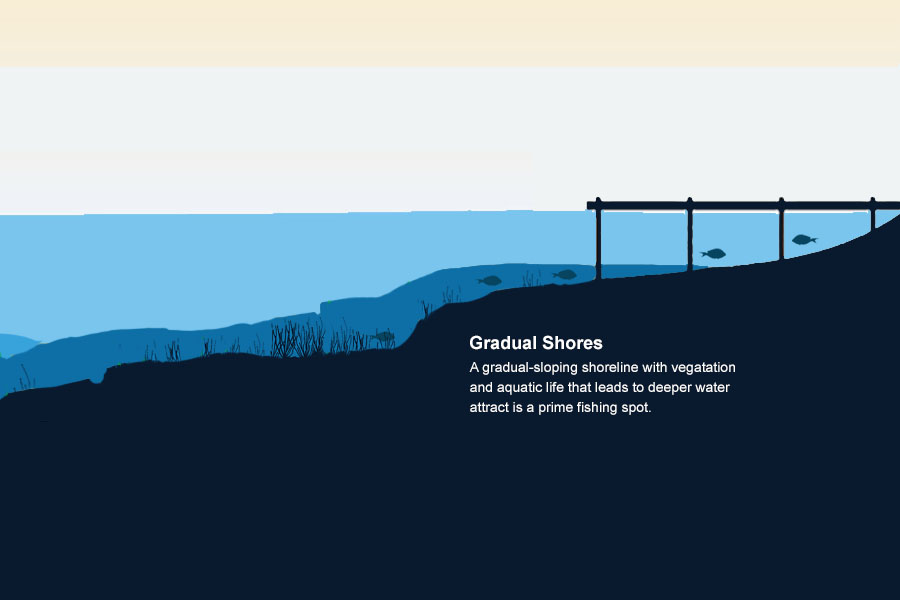
Gradual sloping shores, like any other similar structure that connects a shoreline to deeper water, provide plants that fish use for food. They also provide a path to and from the deeper water, making them a good place to find fish. However, if the slope is too gradual, it will create too much of a shallow area, which won’t be attractive to fish.
Inlets and Outlets
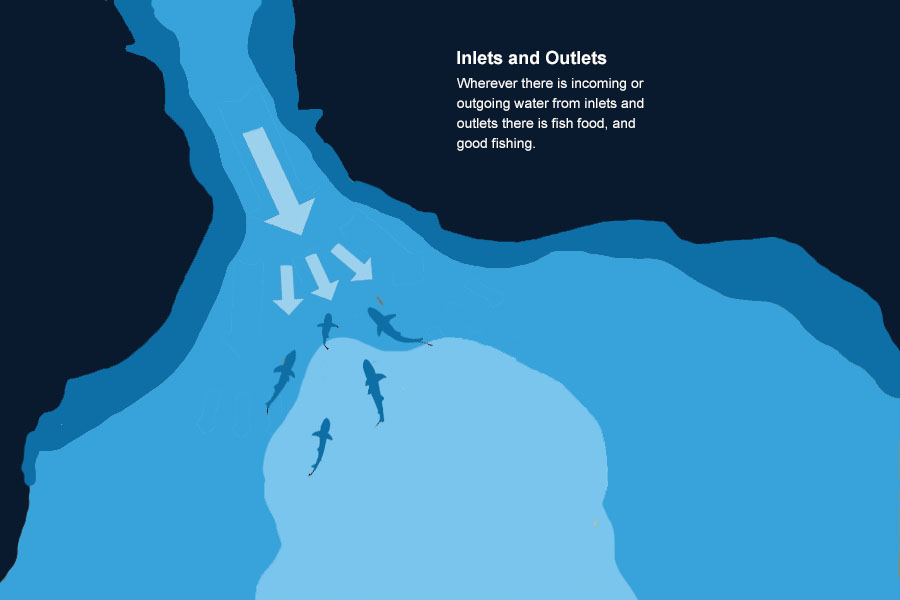
Natural lakes all have streams or rivers feeding into and out of them. The areas where these bodies of water meet are known as inlets and outlets. These are great fishing spots because their vast amount of food sources, coupled with the moving water makes them attractive to game fish.
Spring, in particular, is a great time to fish in inlets and outlets. This is especially true when the water is cool – like when there’s a cold front. During this time, the water near the outlets and inlets will be warmer, making them a good spot for fish to hang out.
Inside Turns and Coves
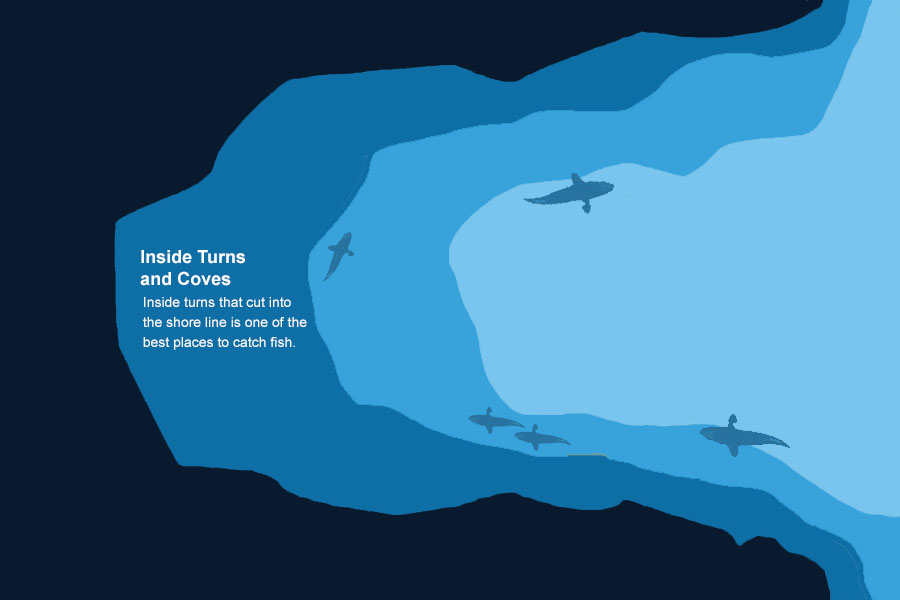
A small inlet that cuts into the shore is known as an inside turn. These are a great place to fish because the shallow water inside the turn gives you another break line. And break lines attract fish.
A larger version of an inside turn is known as a cove. Since these are larger than inside turns, they tend to have more shallows, more shoreline and more protection, which means they usually also have more fish. Baitfish and plants are often found in coves, and where there are small fish, you’ll find game fish. Generally, the best time to catch bigger fish in these areas is early in the morning, or late at night.
Islands or Sand Bars
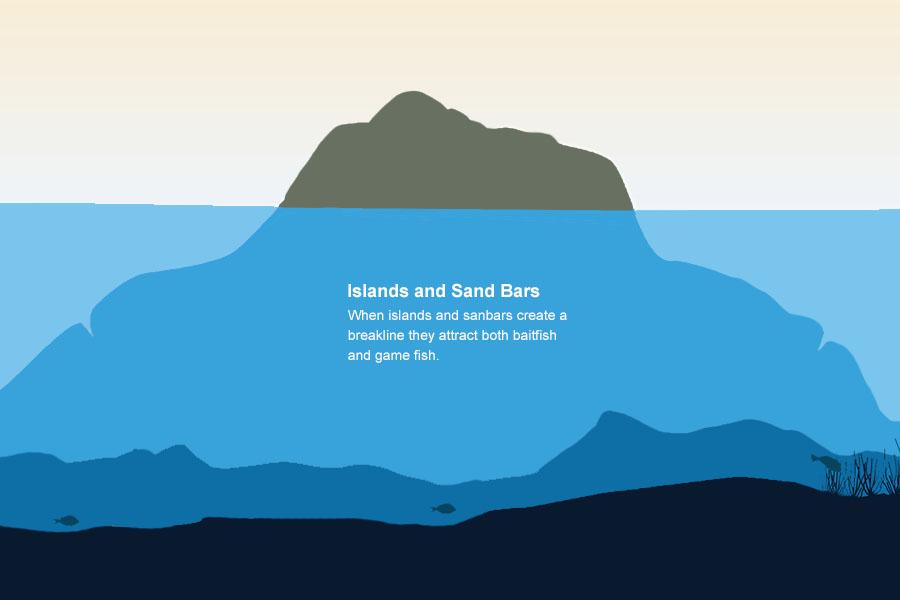
Islands and sand bars are partially submerged pieces of land. If they create a break line where they slowly slope down to the water, they can attract both game fish and baitfish. You can also find currents around islands. These currents often carry small plants and water creatures that also attract fish.
Lake and Pond Fishing Holes
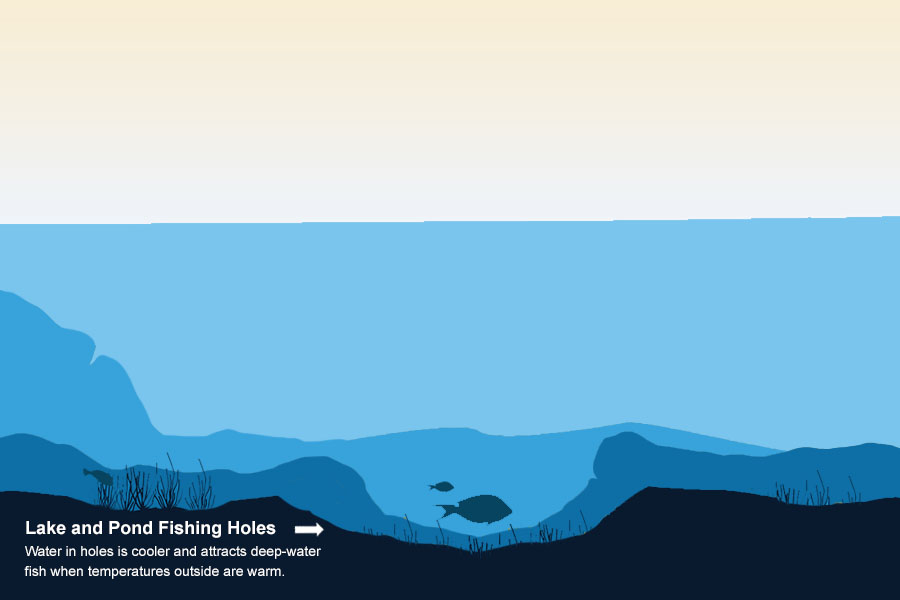
A hole is a basin in a lake that was formed by a glacier. It’s generally the deepest spot in the lake. On hot, summer days, fish are attracted to these areas because the water in these holes is cooler. To find them, you’ll need to use a topographical map.
Lily Pads
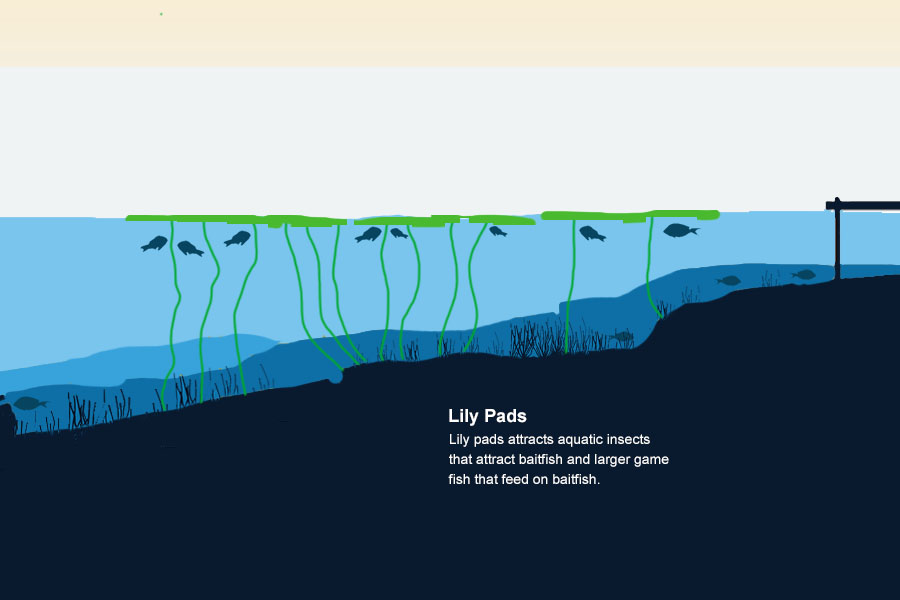
Baitfish are attracted to the bugs and amphibians that live on and around lily pads. And where there’s baitfish, there’s bound to be bigger fish. Fish also like to hang out in spots that offer shade, which include large patches of lily pads. When fishing in these areas, cast into the openings and around the edges, otherwise, you may find yourself with a nasty snag.
Merging Currents
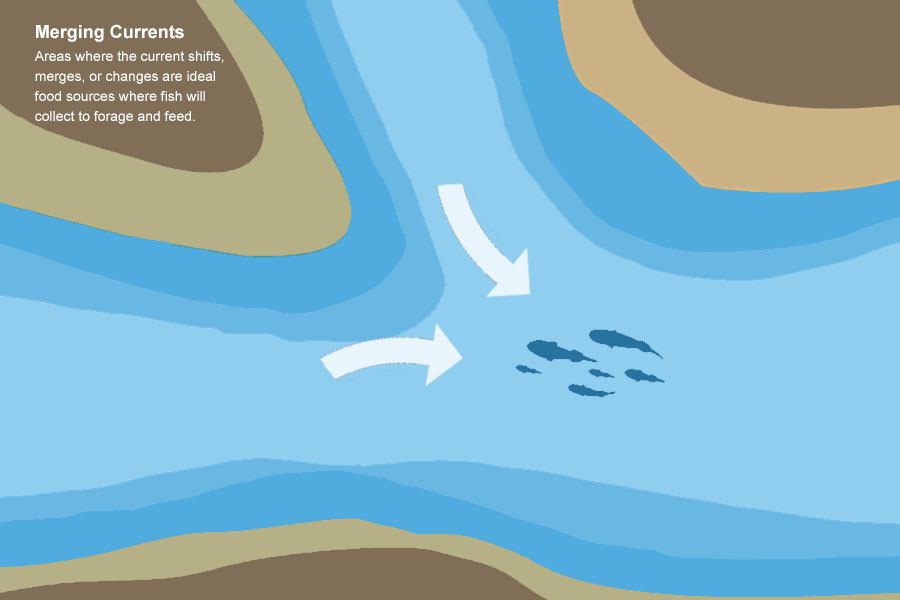
Areas where the current shifts, merges, or changes are ideal food sources where fish will collect to forage and feed. These areas may also include drop-offs, feeder springs, or anywhere else current slows and food may collect.
Open Water
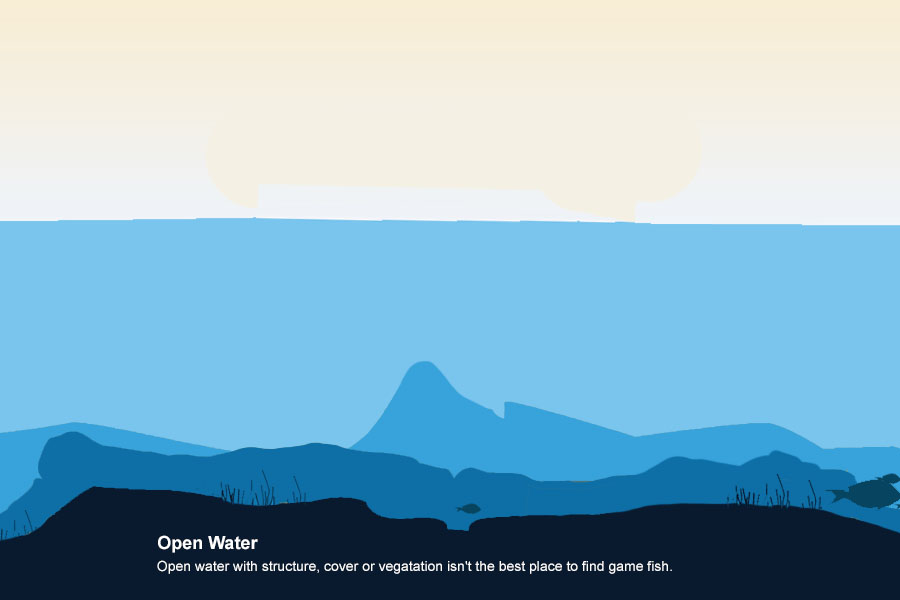
Open water is not the best place to find fish due to the lack of weeds or structures in which fish like to hide. It’s not that you can’t catch fish in open water, it’s just much more difficult.
If you want to fish in open water, try to find an area near a stream or river. Big fish often use these areas to travel when looking for food. You might also get lucky and find yourself over drop-off or deep hole where fish like to hang out to rest. Even so, there are better places on a lake to find fish.
The best time of year to fish in open water is in the late fall or early spring due to the lack of vegetation. During these times, baitfish will venture out into the deeper water looking for plankton to feed on. Keep your eye out for groups of smaller fish – this means there’s a good chance larger fish are nearby.
Outside of Bends
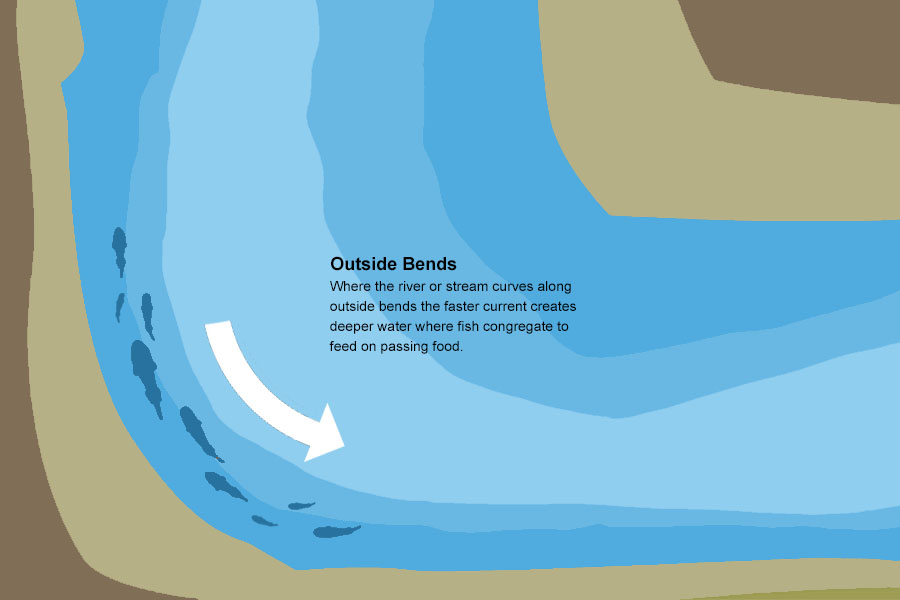
In a river, you’ll find the deepest water in the outside bends in the areas where the current’s force creates deep holes. This is where you’ll find the majority of the fish feeding and just hanging out. You’ll often find steep banks along outside bends due to the erosive power of the strong currents. In many rivers, engineers will place rock riprap in these locations to help slow that erosion. This often creates the ideal spot to catch various fish, like white bass, walleyes and smallmouth bass. During spawning season, you may even find catfish in these areas. If riprap hasn’t been installed, you may find mature trees that have fallen into the water because their roots were dug out by the current. These trees provide a great home for fish like catfish, pike or crappies. Since these trees slow down the current, they supply the fish that choose to live here with plenty of food. They’re also a great place for fish to shelter – and for you to catch those fish.
When fishing in a local river, Google maps can help you find winding spots in the river. This will save you a lot of time trying to find the best places to fish.
Overhanging Trees and Bushes
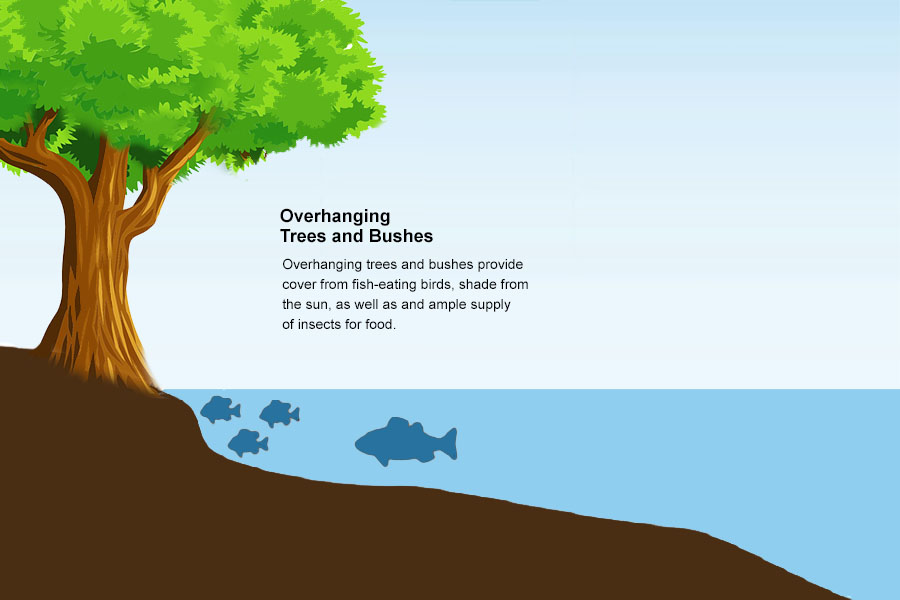
For the best success when fishing in a river, you need to think like a fish. Where are the best spots to make a home or hide out from predators? Look for areas where a structure runs along the bank, like overhanging branches or a sunken tree. But these aren’t the only places to find fish in a river. The ideal spot to fish in a river is anywhere you can find several different natural structures together. These not only offer great places for fish to shelter, but allow predator fish to hide to ambush their prey. Look along the river to find these spots and you’ll find some great fishing.
Piers, Docks and Pilings
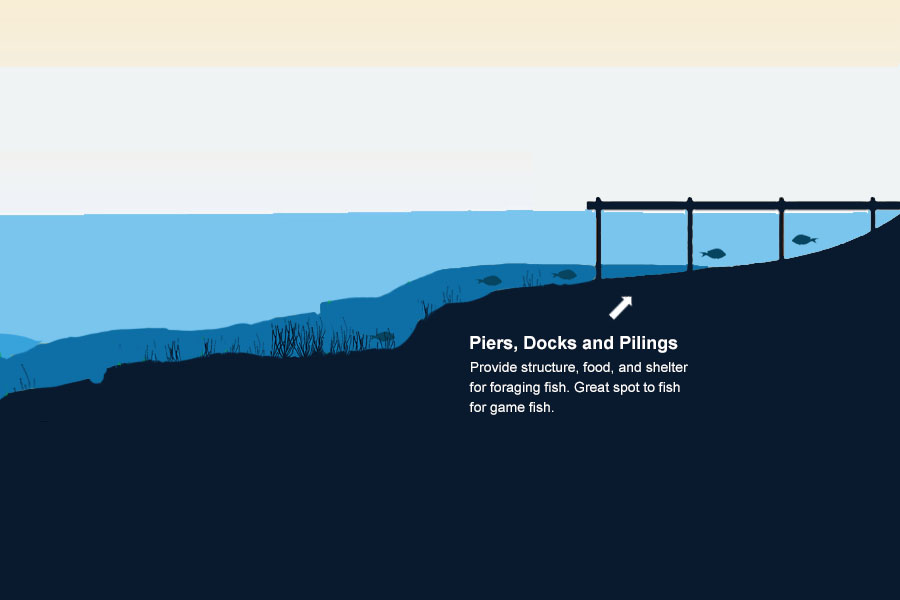
Piers, docks and pilings create an environment where fish can go to seek food and shelter. They’re often covered with weeds and barnacles and also provide shade from the sun. This is the ideal place for many fish to rest and hang out.
Points and Break Lines
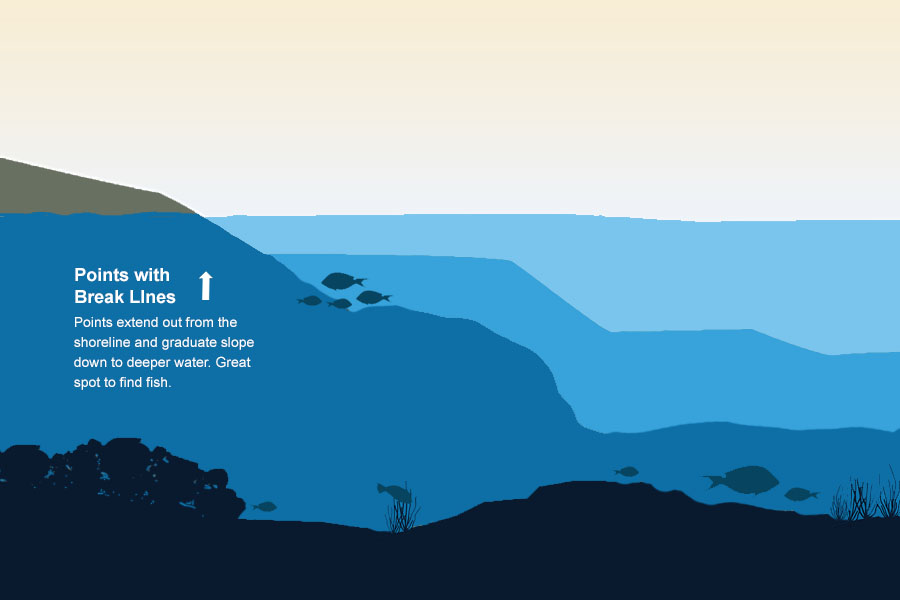
Points extend out from the shoreline and graduate slope down to deeper water. These are a great areas to fish. However, a point with a sudden drop-off or that remains shallow won’t hold as many fish.
The break line that is created from the sloping-out formation of the point is what attracts fish. Fish come up from the deeper water in search of food in the shallows. Fish the tip of the point and where the point curves back toward the shore.
Riparian Zones
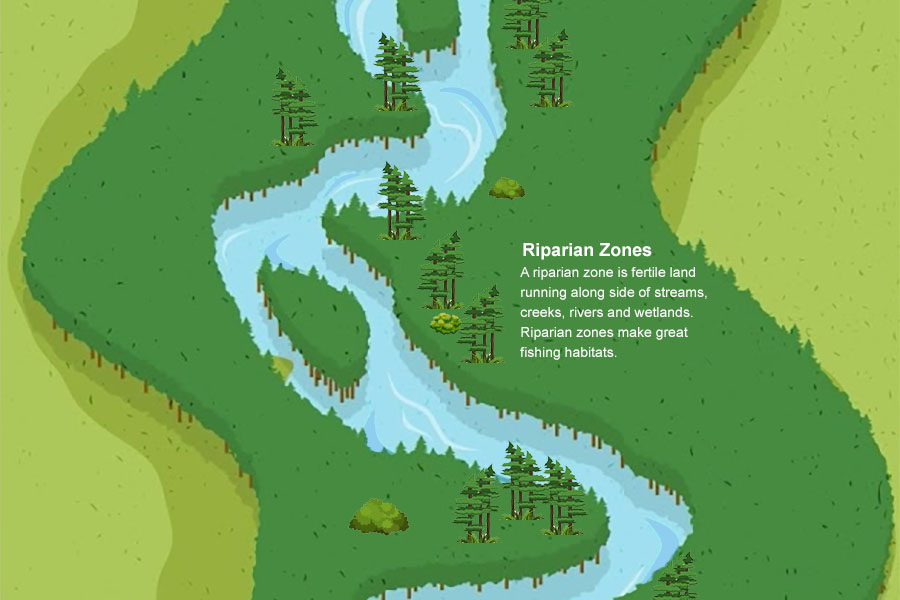
Land that runs along the sides of streams, creeks, rivers, wetlands and gullies is known as a riparian zone. These areas are very unique and tend to be very fertile. If well managed and still in their natural state, they can make great fish habitats. Many different types of fish and creatures live in these areas because of the vast supply of cover, water and food they offer. You’ll find the highest concentrations of fish in bodies of water that run next to riparian areas.
Ripples, Currents, Swirls and Sprays
Ripples, currents, swirls and sprays in the water can indicate any number of things. They can be caused by feeding baitfish, escaping fish, or a big fish diving down to catch a minnow. Whatever the cause of the ripples, currents or swirls, you’ll increase your chances a getting a bite if you cast into them.
Rivers and Streams
River fishing can be extremely relaxing. You don’t need much gear and you can easily do it by sitting in a canoe or simply wading into the water.
If you’ve never tried river fishing, it’s easy to learn. First, find out all you can about the proper fishing gear and tackle to use for freshwater fishing. Then, follow a few tips specific to river fishing and learn which areas along the river typically contain the most fish.
You’ll want to look for areas you think would be good hiding places for fish trying to escape predators. As you look along the banks, watch for structures where fish can hide, such as overhanging branches or fallen trees. There are all sorts of places along a river that provide good hiding spots for fish. The ideal rivers for fishing are those that have many natural structures throughout. These structures will offer protection for the smaller fish and hiding spots where predatory fish can ambush their prey.
Rock and Boulder Pockets
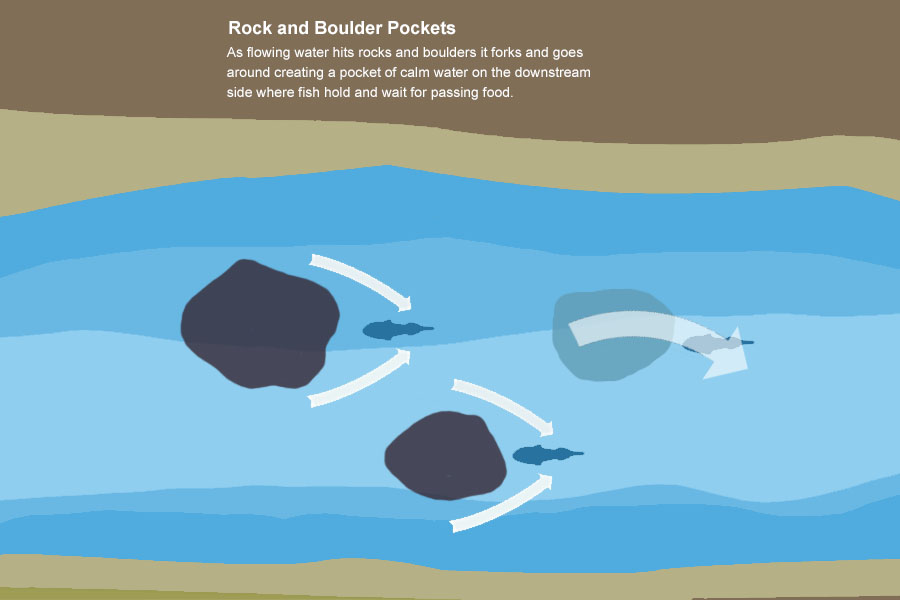
If water is flowing through a river and runs into an obstruction like a rock or boulder, it will split to go around the object. This will make a pocket of calm water form on the other side of the obstruction. It’s in these calmer waters that fish like to rest. Fish can sit here and wait for the current to bring food to them. They’ll then dart out, grab the food, then swim back into the water pocket. It doesn’t matter if the pocket is large or small – either way, you’re likely to find fish there.
Rocks
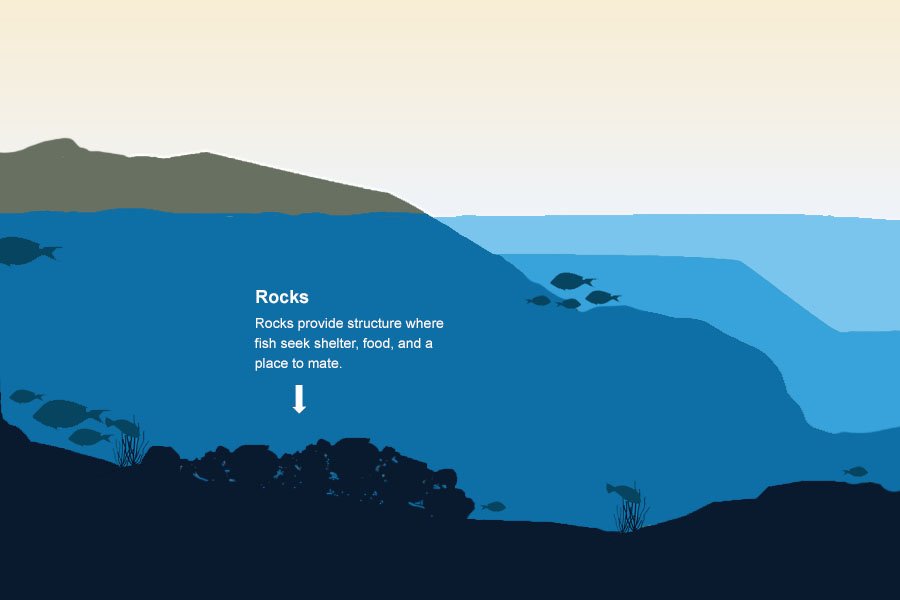
Rocks make great fishing locations because they provide food, shelter and mating grounds for fish. This goes back to the point of always trying to fish near a structure. Rocks located right next to or in deeper water provide the best places for fishing in ponds and lakes. The only negative thing about fishing near rocks is the potential for snags.
Small Pointed Waves
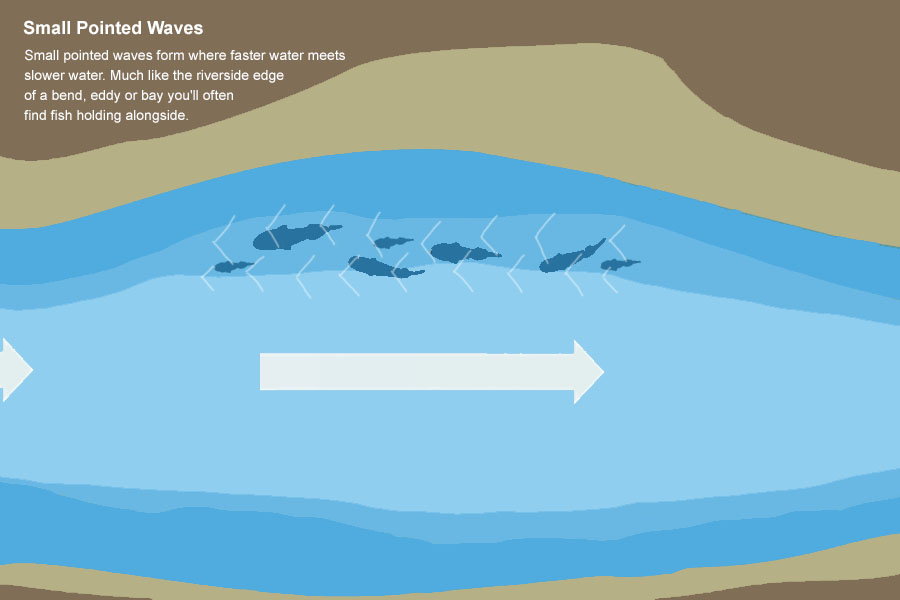
Waves form a triangle shape whenever faster water and slower water meet. This often happens in areas like eddies, bays or along riverside edges of a bend.
Spring Holes
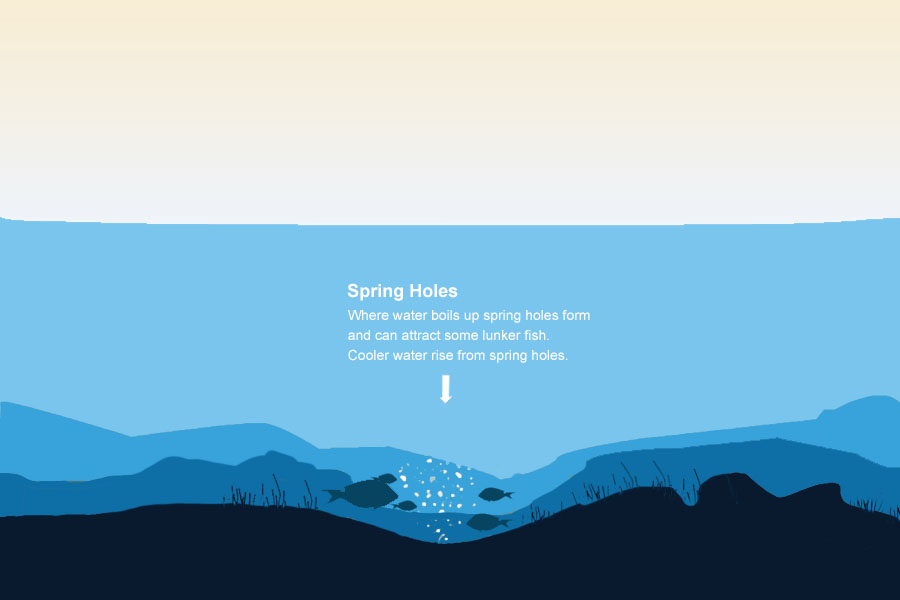
Spring holes make some of the best freshwater fishing experiences. Water boiling up from the bottom of a lake creates these spring holes. Whether the hole is deep or shallow, it often attracts deep-water fish. The only trouble is that these holes aren’t easy to find.
You may be able to find them using a water temperature gauge in the summer. Look for places where cold water borders warmer water, then check the depth. You can sometimes find spring holes in boat harbors where there has been dredging. This can open up springs, which cause colder pockets of water to form in spots protected from the wind. In the winter, when the water freezes, check the lake for spots of open water surrounded by ice. These spots where the water is warmer could indicate a spring below. Make note of these spots so you can come back and fish them in the summer.
Sunken Objects
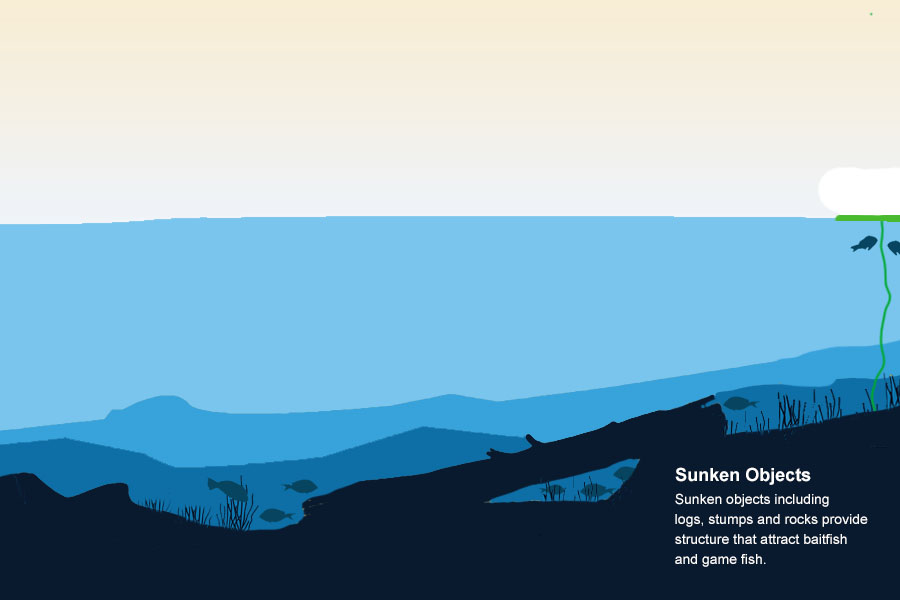
Things that are partially submerged in water, like branches, stumps, rocks and trees are considered structures. And where there are structures, there are also fish. When fishing around structures, you’ll need to be extra careful to make sure you don’t hit an object or snag your line.
Walkways and Bridges
A walkway is similar to a bridge except that it’s specifically built for fishing. You’ll find walkways near or parallel to other structures like shoreline bulkheads, bridges or piers. For example, you may find a walkway on the lower level of a bridge. Walkways are usually built to keep fishermen safe and allow them better access to the water.
Bridges make for excellent fishing spots due to their diversity. They span over deep water, can have rubble from previous bridges, offer protection from the sun and because they act as an obstruction in the water, they create current. When you add all of that up, you have a great place to find fish.


